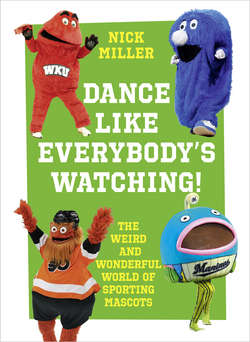Читать книгу Dance Like Everybody’s Watching!: The Weird and Wonderful World of Sporting Mascots - Nick Miller - Страница 6
ОглавлениеStuart MacFarlane/Arsenal FC via Getty Images
INTRODUCTION
A little while ago I was at an Arsenal game. After the final whistle, as 60,000 people trudged away into the London night, I noticed a gaggle of kids and their parents gathering roughly around where the players would eventually emerge. I assumed they were waiting for pictures and autographs from their footballing heroes, but then, instead of a highly skilled and dedicated athlete, a large, green, furry dinosaur made its way out – and was mobbed.
It turns out the kids were waiting for Gunnersaurus, the friendly anthropomorphised dinosaur that, for reasons that aren’t entirely clear, had been adopted as the club’s mascot some time earlier.
All of which reminded me that people think watching sport is about, well, watching sport – sitting down and paying attention only to the period of time during which these men or women run around and perform, their otherworldly talents displayed for us to enjoy, gawp and shout at, and, for a special select few, think we could do better.
But it’s not really. Well, not entirely. If that were true, nobody would talk, read, write or think about sport except for when the game was actually taking place. We wouldn’t wear implausibly expensive merchandise, we wouldn’t follow the players on social media, we would probably pay less attention to interviews with the sportsmen and women, and we would most definitely pay more attention to those better voices of our conscience who make the sadly convincing case that it is, in fact, only a game.
It is, however, the ephemera that keep us going. The things that surround sport that don’t have much to do with it. The bits that might seem superfluous but give the whole thing a little colour. The sauce on the steak; the steak is the most important bit, naturally, but you wouldn’t want it without the sauce.
Things like mascots. Those mostly furry, usually oversized, gaudy characters that prance around the field before, during and after the game, theoretically for the kids to enjoy, but more often than not for the adults to laugh at.
Because, for the most part, these mascots are absurd, surreal concoctions of a dangerous mind, bedraggled rejects from Sesame Street, characters they decided were too weird to be a sidekick to Big Bird.
We’ve had birds, dinosaurs, sheep, cows, fish, worms, tigers, lions, dogs, donkeys, ants, slugs, bats. There have been vegetables, plants, trees, chips, oranges and chillies. Some have tried fur-covered versions of people, aliens and otherworldly made-up creatures that seem to serve no purpose other than to fuel the psychotherapy industry for a generation of scarred youngsters. We’ve seen hammers, household boilers and planes. And then, the last refuge of the lazy mascot-maker, simply the relevant item of sporting equipment, with added limbs.
Essentially, if someone can figure out how to put legs and arms on something, then it can and probably has been tried as a mascot. In many cases they’re strange pieces of performance art, the sort of thing where you daren’t even think about the mental process that brought them into being.
Mascots are inherently absurd, but then again you, dear reader, almost certainly dedicate significant portions of your life to teams of men and women that have very little idea that you exist. If you support a team, given how transient the players, coaches, owners and even stadia are, you’re essentially cheering laundry, as Seinfeld once put it. And if that’s not absurd, then what is?
Which shouldn’t be a surprise. After all, fandom is just as illogical as mascots. The whole idea of mascots is based on the hope that something or someone accompanying the team might have some sort of mystical impact on how that team performs. Clearly ludicrous, but for anyone who’s had a lucky hat, shirt, jacket, socks or underwear, you know why a mascot is there.
Mascots exist as a reminder that we all take this too seriously. Sport isn’t a matter of life and death, and no, it’s not more important than that. It is, as the old saying goes, the most important of the unimportant things, but we still need a nudge every now and then to make sure we know it. What better than the sight of a deranged muppet firing T-shirts into a crowd to do that?
And in the end, whether a mascot is ill-conceived or brilliantly designed, they’re just supposed to be fun. Which is what watching sport is supposed to be.
This is a celebration of mascots. The worst, the best, the silliest, the most absurd, and everything in between. All of the examples in this book could most charitably be described as ridiculous, but the concept itself is fairly ridiculous, so why not go all-out?
Enjoy.
